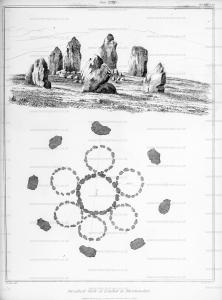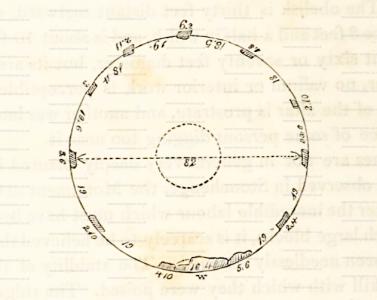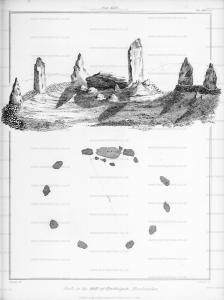Prehistoric Scotland
Prehistoric Scotland is in Prehistoric British Isles.
Europe, British Isles, Scotland, Aberdeenshire, Auchorthie Stone Circle [Map]![]()
Archaeologia Volume 22 Section XV. The remains at Auchorthie [Map] are also very entire, and exhibit a curious arrangement. Most part of the exterior line of stones has been filled up, to constitute a fence; it is consequently difficult to determine whether there has been originally any intervening stones in this part, but the inner circles and a part near the Altar are evidently of the original plan. The two stones placed between the exterior and second line are nearly level with the ground. The largest stones are towards the south, but the whole are of rather moderate dimensions. The Altar is 8 feet 6 inches in length. The name may be from the Gaëlic, auch, field, and ortha, prayer.
Europe, British Isles, Scotland, Aberdeenshire, Balgorkar Stone Circle [Map]![]()
Archaeologia Volume 22 Section XV. The Circle at Balgorkar [Map] seems to have consisted of eleven stones, nine only of which remain. The Altar measures 6 feet 9 inches in length, and is 4 feet 6 inches in height outside. The stone at its east end is 6 feet 7 inches high, and 4 feet 6 inches wide at base. About two hundred paces eastward are two stones, a few paces distant from each other, and about seven feet high. These are not seen in the plan.
Europe, British Isles, Scotland, Aberdeenshire, Balquain Stone Circle [Map]![]()
Archaeologia Volume 22 Section XV. Eight stones remain of the Circle at Balquhain [Map]. The altar is 13 feet long, 2 feet wide, and 4 feet high, and rests on another block, level with the ground. The obelisk is thirty feet distant eastward, of a triangular form, each face 3 feet and a half in width, and is about 10 feet high. The Circle is about sixty or seventy feet diameter, but its area having been ploughed over, no vallum or interior work is perceptible. One of the lateral stones of the altar is prostrate, and another was lately overturned in consequence of some persons digging too near it.
These stones are not in general very deeply planted in the ground. This has been observed in Stonehenge, the Monument at Carnac in Brittany, &c. After the incredible labour which must have been bestowed in procuring such large blocks, it is scarcely to be believed that their height would have been needlessly lessened. The stability of these erections evinces the skill with which they were poised. The ridge or vallum, so often observable, has perhaps been useful in supporting their position.
Europe, British Isles, Scotland, Aberdeenshire, Echt, Cullerlie Stone Circle [Map]![]()
Archaeologia Volume 22 Appendix. "Another use to which circles were appropriated was for Trial by Combat; but it seems probable that they were chiefly devoted to religious purposes. Great veneration was undoubtedly attached to them, and the ponderous masses inspired awe when their original destination became unknown. Many churches have been built in or near the site of Druidical Temples; several instances of which I have remarked in Scotland: and in the Highlands, to this day, the word Clachan signifies both a circle of stones and a place of worship.
"The First of the accompanying Drawings presents a South View of a singular Monument at Leuchar [Cullerlie Stone Circle [Map]], in the parish of Skene, in Aberdeenshire.b It is situated upon an extensive moor from which turf is cut. From this circumstance it is denominated a Moss, and the appellation Leuchar, seems to be the Gaelic Leu - chra, reedy or abounding in rushes. The Circle is of small dimensions, and the largest stone does not exceed six feet in height. The diameter of the Circle is thirty-four feet. The small Circles contained in the larger present a curious singularity; and it is also remarkable that, at a short distance to the southwest, are nine others of similar dimensions. About a hundred feet south-east is a Cairn; and on a hill in the back-ground is seen another.
Note b. Plate XXXIV.

Europe, British Isles, Scotland, Aberdeenshire, Old Keig Stone Circle [Map]![]()
Archaeologia Volume 22 Section XV. Of the Circle at Old Keig [Map], four only of the stones remain.b Of these, the altar measures about 14 feet in length, 5 feet 4 inches in breadth, and is 4 feet 8 inches in height outside. Its two lateral stones are in height 6 feet, and 5 feet 4 inches, and 3 feet 6 inches, and 2 feet 4 inches in width at base, respectively. The Circle is traced by a vallum of loose stones, and in the centre is a tumulus or cairn.
Note b. pl. XXIII.

Europe, British Isles, Scotland, Aberdeenshire, Echt, Seanhinny aka Sunhoney Stone Circle [Map]![]()
Archaeologia Volume 22 Section XV. The Temple at Seanhinny [Map], in the parish of Midmar, seems to remain as it originally stood, at least in the number and position of its stones; and has been, from a proper feeling, surrounded with trees by the proprietor. There is a central small ridge of stones, but it is not clear whether it has been a circle, or a cairn subsequently opened. The whole area seems full of loose stones, which have been probably thrown into it in clearing the neighbouring fields. The altar is 16 feet 4 inches long, 4 feet 6 inches where broadest, and 2 feet 9 inches high. The lateral stones are 7 feet 6 inches, and 6 feet 7 inches in height, by 5 feet 6 inches, and 4 feet 10 inches in breadth at bottom. As I have taken the measurements of this Circle carefully, I think it will be satisfactory to give a plan of it with these inserted.

Europe, British Isles, Scotland, Aberdeenshire, Tyrebagger Stone Circle [Map]![]()
Archaeologia Volume 22 Appendix. "The Second Drawing presents a View from the interior of a Circle on the hill of Tyrbagger [Tyrebagger Stone Circle [Map]] in the same County.c The name is compounded of the Gaelic words Tyr, land, and Bachar, an acorn; an appellation which may possibly have arisen from the abundance of Oak-trees, which were always attendant on sacred Circles.
"This second Circle consists of ten upright stones, the largest of which is on the south side. It is between ten and eleven feet in height, and is eleven feet in circumference at the base. Beside it is another, eleven feet in length, which, although now prostrate, has originally been elevated on several smaller stones. The diameter of this Circle, from north to south, is fifty-seven feet; and the area has been at one time appropriated for the reception of cattle belonging to the inhabitants of an adjacent cottage, now in ruins; for this purpose it has been hollowed beneath the level of the surrounding soil. The View presents a distant prospect of the hill of Drum min, on the summit of which is seen a Stone of Memorial, and, still more distant, on the same ridge, a sepulchral Cairn."
Note c. Plate XXXV.
